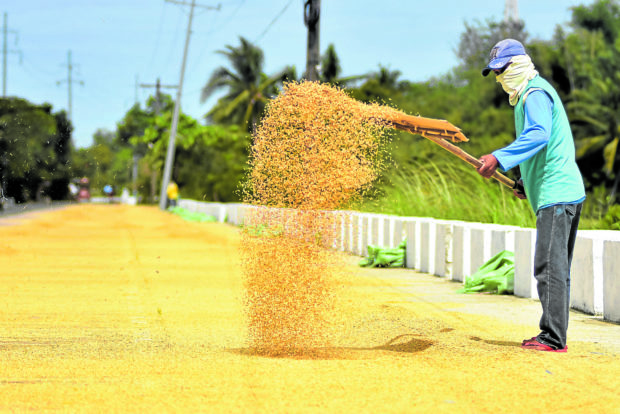
Farmers in Pangasinan and in other parts of the province, including Nueva Ecja have been struggling with falling farmgate prices of palay (unhusked rice).
PHOTO BY WILLIE LOMIBAO
MANILA, Philippines — The Department of Agriculture (DA) on Friday said it is promoting “balanced fertilization” to increase rice growth and production in the country.
DA Undersecretary Leocadio Sebastian said the department recently issued Memorandum Order No. 32, which outlined guidelines on the distribution and use of biofertilizers to boost farmers’ productivity and rice output.
“Ang rice production natin dito sa Pilipinas, nakita natin nitong nakaraang taon, nagkaproblema tayo sa mataas na presyo ng fertilizers, iyong inputs. At nakita namin sa Department of Agriculture, kailangan nating hanapan ng paraan na hindi tayo masyadong umaasa sa imported na inorganic fertilizer,” Sebastian said.
(We have seen that the rice production in the Philippines is being hurdled by the high prices of fertilizers. We saw in the DA that we need to find a way to not depend too much on imported inorganic fertilizers.)
“Isa pa, iyong kalidad ng ating lupa, noong tinitingnan ko, ina-analyze ko iyong situation natin dito sa Pilipinas, bagsak na rin ang soil fertility – iyong kalusugan ng lupa. Alam ito ng ating mga magsasaka. Kahit na buhos tayo nang buhos ng … mayroon tayong fertilizer subsidy, mayroon tayong certified seeds na pinamimigay, nakikita namin na hindi na masyadong umaangat kasi iyong kalusugan ng ating lupa ay bagsak na,” he said.
(We also observed that the quality of our soil is poor. The farmers know this. Even though we give fertilizer subsidies and give certified seeds, production will not increase because the soil is of poor quality.)
With the promotion of the “balanced fertilization,” Sebastian explained farmers would be using organic fertilizer as basal with biofertilizer to improve the growth of rice seedlings.
“Balanced fertilization involves the use of organic fertilizer, biofertilizer, and inorganic fertilizer – combination iyan. So iyon ang ating programa na gusto nating ipalaganap at para ma-maintain natin ang production natin ng bigas dito sa Pilipinas. Kasi we have to make our rice production more sustainable not only today but also in the future,” he said.
(That’s the program that we want to spread to maintain the production of rice in the country. We have to make our rice more sustainable, not only today but also in the future.)
Sebastian said the country’s continued use of inorganic fertilizer is “unsustainable” and the production is “plateauing.”
He added the memorandum order was issued to avoid another “fertilizer scam” that dragged several DA regional directors into the anomalous transaction.
“Iyong memorandum na iyon ay para maiwasan natin iyong kinatatakutan natin na mga fertilizer scam na naman. Kasi iniiwasan natin iyong nangyari noong mga nakaraan, kasi alam na natin iyong leksyon niyan,” the DA official said.
(That memorandum was issued to avoid fertilizer scams. We are avoiding a repeat of the past.)
“So we don’t want a repeat of that fertilizer scam, that’s why we have developed this guideline so that we can have a fair, transparent and sure implementation o kaya iyong implementation natin ay maganda para ma-attain natin kung anuman iyong magandang outcome ng paggamit ng biofertilizer,” he added.
The scam involved the diversion of some P728 million in fertilizer funds to the political campaign in 2004 general elections #
Measures in place to mitigate effects of El Niño on rice production
Sebastian also assured the public that the DA has put in place necessary measures and preparations to mitigate the effects of the looming El Niño phenomenon on the country’s rice production.
“Naghahanda naman kami sa Department of Agriculture kaya lang ako I had experience several El Niño and I’ve also found solutions to El Niño. Mayroon positive and negative na effect ang El Niño,” he said.
He explained the DA is conducting an assessment of areas that could be negatively or positively affected by the dry spell.
“The areas that were be affected negatively doon lang kami gumawa ng mga measures to mitigate the effect, but those areas will have positive effect, iyong positive effect kasi ng El Niño ay iyong maganda iyong solar radiation, iyong init ng araw na nagpapataas ng ani,” the DA official added.
According to Sebastian, there are areas in the Philippines that produce very high palay yield even during the El Niño. He added the DA is focusing on those areas to optimize its intervention and increase production.
“So, hopefully maba-balance out iyong negative at saka iyong positive at kung successful tayo, we may even gain from those areas we’re will have positive effect of El Niño,” he said.
Last month, President Ferdinand R. Marcos Jr. ordered government agencies to prepare for the possible impact of the El Niño phenomenon, which is expected to hit the country in the last quarter of this year or the first quarter of 2024.
The President also instructed various agencies to ensure “protocol-based and scientific” long-term solutions to the impending problem and for them to come up with a campaign to generate public awareness on water and energy conservation.
Philippine Atmospheric, Geophysical and Astronomical Services Administration (PAGASA) said last month that the probability of the occurrence of El Niño is 80 percent for the months of June, July, and August, and 86 percent for the months of November, December and January although the country may experience heavy rainfall events prior to its impact.
RELATED STORY:
DA banking on China fertilizer deal